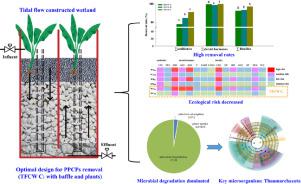Water Research ( IF 12.8 ) Pub Date : 2021-01-22 , DOI: 10.1016/j.watres.2021.116870 Yu-Xiao Cheng , Jun Chen , Dan Wu , You-Sheng Liu , Yong-Qiang Yang , Lu-Xi He , Pu Ye , Jian-Liang Zhao , Shuang-Shuang Liu , Bin Yang , Guang-Guo Ying

|
Research on decentralized wastewaters deserves special focus due to the potential abundance of emerging organic pollutants including pharmaceutical and personal care products (PPCPs), which might pose serious threats to the local water bodies and even to human health. Constructed wetland (CW) is a common decentralized wastewater treatment technology, with a certain ability to eliminate PPCPs. Nonetheless, PPCPs removal in common CWs is frequently challenging, besides, the removal mechanism remains elusive. Based on our previous study, tidal flow constructed wetlands (TFCWs) is effective in nitrogen removal. Here, 3 TFCWs with different modifications (baffle, plants, both baffle and plants) were constructed to treat raw domestic sewage and specifically to evaluate the removal efficiencies and mechanism of PPCPs. 24 PPCPs including 7 antibiotics, 8 steroid hormones and 9 biocides were detected in the level of 1.10 ± 0.29 ng/L-799 ± 10.6 ng/L in the influents. Consequently, we found that modification with both baffle and plants significantly influenced the removal of PPCPs. Moreover, the highest removal rates of biocides (97.1 ± 0.29%), steroid hormones (99.8 ± 0.02%), and antibiotics (90.2 ± 1.60%) were achieved via both baffles and plants in TFCWs. Based on the mass balance analysis, microbial degradation dominated the removal of PPCPs with a percentage higher than 85.7%, followed by substrate adsorption (5.22 × 10−2–14.3%) and plant uptake (1.66 × 10−3–0.44%). Further, 16S rDNA sequencing analysis revealed that the presence of baffle and plants improve the removal efficiency of PPCPs by means of enhancing microbial diversity and changing dominant microorganisms. Moreover, Thaumarchaeota was potentially the key microorganism in the phylum level for PPCPs elimination by TFCWs through LEfSe (linear discriminant analysis (LDA) effect size) analysis. These findings provide new insights into the removal of PPCPs in CWs.
中文翻译:

在带有挡板和植物的新型潮汐湿地中,高度增强了药物和个人护理产品的生物降解
由于新出现的有机污染物(包括药品和个人护理产品(PPCP))可能会大量存在,因此对分散废水的研究值得特别关注,这可能会对当地水体甚至人类健康造成严重威胁。人工湿地(CW)是一种常见的分散式废水处理技术,具有一定的消除PPCP的能力。尽管如此,普通CW中的PPCP去除通常具有挑战性,此外去除机理仍然难以捉摸。根据我们之前的研究,潮汐人工湿地(TFCWs)可有效去除氮。在这里,建造了3种不同修饰的TFCW(挡板,植物,挡板和植物)来处理生活污水,并专门评估PPCP的去除效率和机理。24种PPCP,包括7种抗生素,在进水中检测到8种类固醇激素和9种杀菌剂,浓度为1.10±0.29 ng / L-799±10.6 ng / L。因此,我们发现用挡板和植物进行修饰都会显着影响PPCP的去除。此外,通过TFCW中的挡板和植物,杀虫剂(97.1±0.29%),类固醇激素(99.8±0.02%)和抗生素(90.2±1.60%)的去除率最高。根据质量平衡分析,微生物降解以PPCP的去除占主导,去除率高于85.7%,然后是底物吸附(5.22×10 通过TFCW中的挡板和植物,杀虫剂(97.1±0.29%),类固醇激素(99.8±0.02%)和抗生素(90.2±1.60%)的去除率最高。根据质量平衡分析,微生物降解以PPCP的去除占主导,去除率高于85.7%,然后是底物吸附(5.22×10 通过TFCW中的挡板和植物,杀虫剂(97.1±0.29%),类固醇激素(99.8±0.02%)和抗生素(90.2±1.60%)的去除率最高。根据质量平衡分析,微生物降解以PPCP的去除占主导,去除率高于85.7%,然后是底物吸附(5.22×10−2 –14.3%)和植物吸收(1.66×10 −3 –0.44%)。此外,16S rDNA测序分析表明,挡板和植物的存在通过增强微生物多样性和改变优势微生物而提高了PPCP的去除效率。此外,在通过LEfSe(线性判别分析(LDA)效应大小)分析通过TFCW消除PPCP的门扇水平中,伞形藻可能是关键微生物。这些发现为去除化学武器中的PPCP提供了新的见解。


























 京公网安备 11010802027423号
京公网安备 11010802027423号